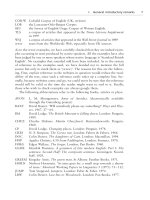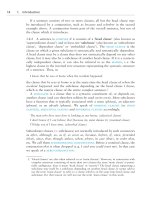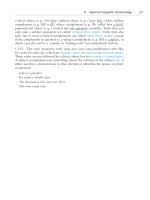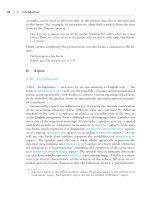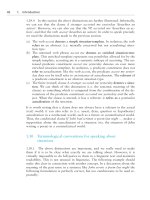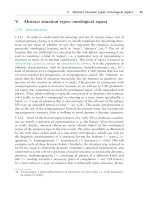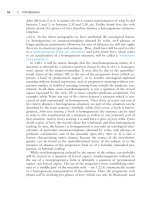The grammar of the english verb phrase part 42 ppsx
Bạn đang xem bản rút gọn của tài liệu. Xem và tải ngay bản đầy đủ của tài liệu tại đây (55.31 KB, 7 trang )
280 5. The absolute use of the present perfect
then ‘account for’ the twenty years, and are thus treated as filling the period
up to now. In other words, the subsituations mentioned are selected according
to what the speaker deems relevant as filling and characterizing the period
leading up to now. (This phenomenon is similar to the phenomenon that one
can say I am establishing a multinational corporation although one is actually
watching a movie at t
0
.)
In the example under discussion, the perfect forms refer to situations which
fill a period leading up to now that is set up by the time-specifying adverbial
in the preceding sentence: for the last twenty years establishes an Adv-time. As
noted in 2.23.1, an Adv-time ‘contains’ the situation time (in terms of either
inclusion or coincidence Ϫ in this example it is in terms of coincidence). Since
one of the uses of the progressive form is to express that a situation is con-
tinuous (i. e. in progress) throughout a given period, the progressive form is
used to refer to the present perfect situation filling the pre-present. In sum, the
only difference between (4) and (5) below is that the filled Adv-time is a past
time span in (4) and a pre-present one in (5):
(4) From two to four I was writing a letter to our sponsors.
(5) (uttered on coming out of the study) For the last two hours I’ve been writing a
letter to our sponsors.
Examples (6) and (7) are similar to (5), except that in (7) the pre-present period
is to be inferred rather than being expressed by a time-specifying adverbial:
(6) What have you been doing for the last two hours? (ϭ ‘With what action(s) have
you filled the last two hours?’)
(7) What have you been doing? (This implies something like ‘since I last saw you’,
which could imply a period of two minutes, as in A couple of minutes ago you
disappeared, but now you’ve reappeared and I can see you’ve been up to some-
thing: what have you been doing?, or twenty years, as above.)
The fact that questions (6)Ϫ(7) can easily be put to someone who is just coming
in, or has just come in, makes it clear that the progressive form is not used to
trigger a continuative interpretation: the situation(s) referred to by have been
doing are not continuing at t
0
. The perfect forms do not receive an indefinite
reading either, because the time at which the situation time of the hypersitua-
tion is temporally located (in terms of coincidence) is each time quite definite,
since it is a period whose terminal point is adjacent to t
0
(and the latter is the
most definite time conceivable, since it is the speaker’s deictic centre). The only
interpretation that makes sense is an up-to-now reading. Because (6) and (7)
ask for specificational information, this reading is a (nonquantificational) con-
stitution interpretation rather than an unmarked up-to-now reading.
5.27.2 This conclusion is in keeping with the observation (made in 5.18.3)
that a present perfect sentence implicating a ‘direct’ (see 5.37.1) present result
VI. The relation between the W-readings and (non)progressive aspect 281
receives an indefinite interpretation, which means that it refers to a bounded
(complete) situation and is therefore in the nonprogressive form. Compare:
I’ve emptied the cesspool. (direct result: the cesspool is now empty)
I’ve been emptying the cesspool. (The speaker does not suggest that the cesspool is
empty, but may be explaining why he smells awful Ϫ see 5.18.3.)
This means that the progressive form does not normally implicate the coming
about of the direct present result of a pre-present telic situation, but can de-
scribe the pre-present situation itself. Thus, unlike I’ve emptied the cesspool,
which implicates ‘The cesspool is now empty’ (ϭ the direct present result of
the pre-present telic situation of my emptying the cesspool), I’ve been emptying
the cesspool describes the situation itself.
In other words, while the present perfect is normally nonprogressive on an
indefinite reading, a nonquantificational constitution reading as a rule requires
the use of the progressive form (if the conditions for its use are satisfied, e. g.
the VP must be dynamic and agentive). For example, compare the sentences in
the following pairs:
(a) I have been redecorating the drawing-room. (nonquantificational constitution
reading or unmarked up-to-now reading: the speaker is not concerned with a
possible direct present result but with the nature of his action filling the pre-pres-
ent)
(b) I have redecorated the drawing-room. (indefinite reading: the speaker is primar-
ily concerned with the direct present result ‘The drawing-room is redecorated
now.’)
(a) [“Who’s going to answer the application letters?”] Ϫ “I’ve already answered the
application letters.” (indefinite reading: the stress is on the direct result ‘The
application letters do not need answering any more.’)
(b) I have been answering the application letters this morning. (nonquantificational
constitution reading or unmarked up-to-now reading: the speaker tells the hearer
what he has spent this morning doing, i. e. what his pre-present actions have
been.)
(a) [So this is Christmas] and what have you done? (from John Lennon’s song
Happy Christmas (War is Over)) (indefinite reading; the speaker is concerned
with the direct result of the action: ‘What have you achieved?’.)
(b) What have you been doing in the past year? (nonquantificational constitution
reading: the speaker wants to know how the pre-present (ϭ the past year) has
been filled ‘situationwise’.)
(a) [“Oh, there you are.] What have you been doing?” Ϫ “I’ve been writing letters.”
(nonquantificational constitution readings)
(b) [“Oh, there you are.] Where have you {been / *been being}?” Ϫ “I’ve {written /
been writing} three letters.” (nonquantificational constitution readings, but the
progressive cannot be used in the question because be is used as a stative verb;
282 5. The absolute use of the present perfect
the reply I have been writing three letters is fine because Where have you been?
is reinterpreted as ‘What have you been doing?’.)
In the following examples, both the question and the reply receive a nonquanti-
ficational constitution reading:
“What have you been doing today?” Ϫ “I have been studying.” (The question says:
‘Tell me about your pre-present action(s).’ The reply describes the action.)
“Where have you been?” Ϫ “I’ve been making up the beds.”
“What have you been doing?” Ϫ “I’ve been shopping.”
5.27.3 The only case in which a present perfect sentence yielding a nonquanti-
ficational constitution reading does not have to be progressive is when it is a
‘specificational’ (see 5.20) question whose presupposition is formulated in the
form of a clause with an indefinite present perfect. (An indefinite perfect is not
normally progressive.) For example:
What {has happened / has been happening} to you? (specificational: the speaker
asks for the specification of a value for the presupposed variable ‘the x that has
happened to you’.)
The presupposition ‘Something has happened to you’ yields an indefinite read-
ing, but the sentence as a whole asks for specification of the nature of the
relevant situation(s) in the pre-present and is therefore given a nonquantifica-
tional constitution reading (see 5.19.1). Because both aspects of interpretation
are present, the verb form may or may not be progressive.
5.28 The duration-quantifying constitution reading and
(non)progressive aspect
In the previous section we have seen that as a rule the progressive form needs
to be used (in verb phrases that are dynamic and agentive) if the present perfect
sentence is to receive a nonquantificational constitution reading, i. e. when the
focus is on the nature of the situation(s) filling the pre-present. By contrast,
the progressive form is never used if the present perfect sentence measures the
duration of the pre-present, i. e. when it receives a ‘duration-quantifying’ (see
5.19.1) constitution interpretation:
Seven long years have {passed / *been passing} since the death of my wife.
Six months have {elapsed / *been elapsing} since then.
The reason for this is obvious. In the duration-quantifying reading, the sentence
expresses the result of ‘measuring’ the pre-present. The situation referred to is
therefore the state of the pre-present having a certain duration. States are not
normally referred to by a progressive form. Besides, measuring the duration of
a period requires considering it from beginning to end. The situation of a
VI. The relation between the W-readings and (non)progressive aspect 283
period having a certain duration must therefore be represented as bounded Ϫ
see 1.46.2). It follows that the progressive form cannot be used, because the
progressive refers to a middle part of the situation only and thus fails to repre-
sent it as bounded. (This is true irrespective of the tense used. There are very
few contexts in which one can talk of seven years as being in the process of
passing, whatever the tense: *Seven years {have been / are / were / will be}
passing {since my accident / before my graduation}. Only sentences referring
to a predetermined (and ‘pre-measured’) situation, like a prison sentence, form
an exception: My seven years of imprisonment are passing, [but I still have
three to go].)
5.29 The number-quantifying constitution reading and
(non)progressive aspect
5.29.1 For the same reason, the progressive form is not normally used when
the sentence is to receive a ‘number-quantifying constitution interpretation’ (see
5.19.1), i. e. when the focus is on the number of discrete occasions on which a
situation has actualized in the pre-present:
How many times have you {visited / *been visiting} Ireland?
He’s {insulted / *been insulting} me three times so far!
I {have eaten / *have been eating} steak tartare at least five times since we’ve been
on holiday.
When the speaker is concerned with measuring a hypersituation by counting
the number of times a subsituation has actualized (or, which amounts to the
same thing, the number of subsituations constituting the hypersituation), it is
very improbable that he is thinking of these actualizations as incomplete (i. e.
in progress). Still, it is not impossible for the speaker to scan the pre-present
for actualizations and at the same time be concerned with their on-goingness.
However, this is only possible when the context provides the temporal vantage
points from which the subsituations are viewed as in progress:
Four times, I’ve been working on my dissertation but had to leave off doing so.
(ϭ ‘So far there have been four occasions when I was in the process of working on
my dissertation when I had to stop and do something else.’)
In such sentences it is not the ‘hypersituation’ filling the pre-present period
that is represented as in progress. On a quantificational constitution reading
the hypersituation filling the pre-present is always a state. States are not nor-
mally referred to in the progressive form. If the progressive is used, it is the
individual subsituations whose number is counted that are represented as in
progress (as in the above example). In other words, the above example does
not form an answer to ‘Has the hypersituation of your-working-on-your-disser-
284 5. The absolute use of the present perfect
tation-four-times been in progress throughout a period leading up to now?’ but
answers the question ‘How many times has a situation of your-working-on-
your-dissertation been in progress in a period leading up to now?’. The sentence
is therefore interpreted as ‘So far there have been four situations of my being
in the process of working on my dissertation …’.
5.29.2 As noted in 5.21.3, a sentence receiving a number-quantifying constitu-
tion interpretation sometimes refers to a series of situations, the last of which
is in progress at t
0
. Even in that case the perfect form must as a rule be nonpro-
gressive, except if all the subsituations are explicitly represented as ‘background
situations’ (i. e. if the context provides the temporal vantage points from which
the subsituations are viewed as in progress):
This is the third time I {have watched / *am watching / *have been watching}
this programme.
This is the third time I {*have watched / *am watching / have been watching} this
programme and been interrupted.
This is the third time I’ve been watching this programme when you’ve arrived. [I
don’t really watch this rubbish every week, you know. It’s just a coincidence that
the only times I’ve watched it, you’ve arrived during my watching it.] (Each of the
subsituations referred to by I’ve been watching this programme is a background situ-
ation.)
These examples illustrate the following:
(a) In spite of the fact that there is a situation of watching in process at t
0
,
the present tense cannot be used in Standard English (while it must be used
in most other Germanic languages in this type of sentence expressing a
number-quantifying meaning). The fact that the speaker is concerned with
the question of how many times a situation has actualized in a period
leading up to now is apparently sufficient to require the use of the present
perfect in English.
(b) On a number-quantifying constitution interpretation, the present perfect
form which has to be used is not normally a progressive form, unless all
the pre-present subsituations are explicitly represented as background situ-
ations.
5.29.3 In some cases, the ‘series’ of situations constituting the hypersituation
(referred to in a sentence receiving a number-quantifying constitution reading)
is a set which is a singleton Ϫ see 5.21.3. In that case the one and only actual-
ization of the situation may be in progress at t
0
. Even then, the tense to be
used is the present perfect because a hypersituation (consisting of a gap and
one subsituation) is said to fill a period leading up to now.
VI. The relation between the W-readings and (non)progressive aspect 285
This is the first time you {have spoken / *are speaking} to me.
Is that the first cigarette you {have smoked / *are smoking} today?
In such examples, the progressive form cannot be used (even though the single
subsituation is in progress at t
0
), unless the subsituation is explicitly represented
as a background situation during which another situation actualizes:
[Now that I come to think of it,] this is only the first cigarette {I’ve smoked / *I’ve
been smoking} today.
[Now that I come to think of it,] this is only the first cigarette I’ve been smoking
today [and had to throw away.]
The latter sentence means ‘Of the cigarettes I’ve smoked today, this is the first
one that I’ve had to throw away while I was smoking it’. This means that This
is the first cigarette I’ve been smoking today and had to throw away does not
make two discrete statements Ϫ ‘this is the first cigarette today’ and ‘I’ve had
to throw it away’ Ϫ but only one: ‘This is the first cigarette today I’ve had to
throw away while smoking it’. This statement implies that the present subsitua-
tion is not the first today: there has been at least one subsituation of my smok-
ing a cigarette earlier today which was not interrupted by my having to throw
it away.
In sum, the following rules apply in the relative clause forming part of the
pattern ‘{definite NP (e. g. it / this / that / that cigarette} ϩ is the ϩ ordinal
numeral or superlative ϩ noun head ϩ relative clause’ if the reference is to a
pre-present hypersituation consisting of a number of subsituations of which
the last is located at t
0
:
(a) The relative clause uses a progressive present perfect form if the present
subsituation is seen as background for another situation. The time of the
latter situation is the vantage time from which the background situation
is seen as being in progress:
This is the first letter I’ve ever been writing [and couldn’t finish because of a
bomb scare.]
This is the second time I {have been speaking / *am speaking} to him [and {have
had / had} to put the receiver down because someone came into the room.]
(b) Otherwise, the relative clause uses a nonprogressive present perfect form:
This is the first time (that) she {has gone out / *goes out / *is going out / *has
been going out} for months.
This is only the second time (that) I {have paid / *pay / *am paying / *have been
paying) a contribution.
That’s the fifth glass of champagne (that) he {has drunk / *drinks / *is drinking /
* has been drinking} today.
The painting he’s working on now is the best he {has produced / *produces / *is
producing / *has been producing} since he started painting two years ago.
286 5. The absolute use of the present perfect
As noted in 5.21.3, the temporal interpretation of the clause in the present
perfect here combines a quantificational constitution reading Ϫ the speaker is
concerned with the number of actualizations in a period leading up to now Ϫ
with a partly continuative interpretation: the last situation in the series is in
progress at t
0
. However, the quantificational constitution aspect of meaning
rules out the use of the progressive, unless this form is needed to represent the
individual subsituations as background situations for something else, as de-
scribed in (a).


